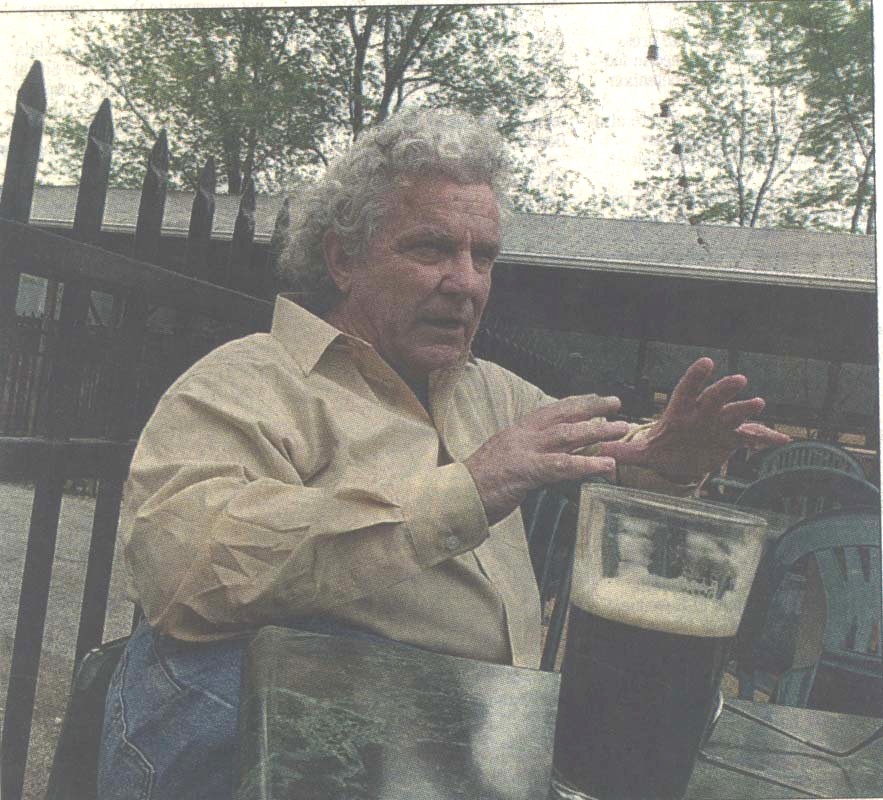

Bob Corbett, instrumental in the formation of a Dogtown historical society, discusses the history of the area over a pint of Guiness at Seamus McDaniels.
Dogtown, one of St. Louis' oldest and most intriguing neighborhoods, finally has its own historical society. The 12-member organization was created in March but held its first formal meeting April 13.
Society board member and Dogtown scholar Bob Corbett was instrumental in founding the group and providing it with a wealth of historical data.
Corbett, a retired professor of philosophy at Webster University, began researching the neighborhood history three years ago. In 1999; he launched a website, which among other things, contains information of Dogtown's past and present.
"Every time I would meet people, I would say, `Are you online?' Finally, with nine people I started the Dogtown e-mail list," Corbett said over a glass of Guinness at Dogtown's Seamus McDaniel's. "We now have 160 people on that list."
In January, Corbett returned from his ninth trip to Austria as a visiting professor and called a meeting of the people on his e-mail list. The group brainstormed and talked and by March the society was registered with the state.
Corbett doesn't like to take credit for his work, saying, "I was the convening person but the society founded itself."
He will continue to work with the society but vows to keep a low profile and, above all, his independence. "I've made it clear I am not an organization person," Corbett said. "I will operate completely independently of the society."
However, 63-year-old Corbett is a Dogtown artifact in his own right. A well-seasoned traveler and a philosopher by both vocation and spirit, Corbett has roamed the world East to West.
In 1962, he and his now-former wife went to the Bahamas and taught as volunteer teachers for two years.
In 1965, Corbett started lecturing at Webster University, where he remained anchored until his retirement last year. But Corbett didn't stick around during his tenure. He traveled almost every year. Corbett spent time in Haiti, Austria, France, Eastern Europe and the Arabian Peninsula among other places.
Enamored With Austria, Corbett says he, misses Vienna's outdoor cafes, where he spent countless hours reading and discussing literary works.
Also, America is a materialist culture and Europe is dominantly an intellectual culture," Corbett said. "Art, intellect and ideas matter. Ordinary working people from the working-class neighborhoods know classical music and go to the standing room at the Vienna Philharmonic. I relish that culture."
Corbett has the know-how, the means and certainly the market to take his endeavors to the next logical level-publish a book on Dogtown history. But he won't do it.
"I don't like the notion of selling intellectual property unless there is a need," Corbett said. "I am a fanatic about accuracy and completeness and a project like the history of Dogtown is going to take years before I get a product that is in anything like a completed state. I change and update daily."
In addition, Corbett says, putting information online is the democratization of knowledge that helps people learn. Knowledge, Corbett says, shouldn't be caged into print.
A self-professed fanatic of accuracy, Corbett says there are two myths that have repeatedly grated on his nerves.
"While there is a lively myth about Dogtown's Irishness and the myth is alive and well -- it's false," Corbett said. "Dogtown had a significant Irish heritage. Unlike The Hill, which was always exclusively Italian, Dogtown was never exclusively Irish. We had large German Jewish and German Protestant communities. We've always had significant populations of Italians and Croatians."
The second misconception is the name of the neighborhood itself.
Many people believe the name comes from the 1904 World's Fair exhibit of Igorots, a tribe that, according to the legend, made frequent forays into the neighborhood to steal dogs for their daily meals.
“This is absurd," Corbett said. “This used to be a rough neighborhood. These were miners and brick-factory workers. If the neighborhood had had scantily-clad black people coming in here and, stealing dogs, Forest Park would have been littered with Igorots. If you sneezed wrong, they'd beat the crap out of you when I was a kid."
The predominantly miners' area got its name because many households kept dogs, according to Corbett.
“On Manchester there were the train tracks, where hoboes came to pick bricks and gold and silver because there was a smelting plant there," Corbett said. "Hoboes rode the train and the miners were worried about the women sitting home with the kids, so they all had dogs."
Two of the society's major projects are collecting oral histories from elderly, long-time residents of Dogtown and putting up plaques with names of prominent Dogtowners on the north wall of Seamus McDaniel's tavern, 1208 Tamm Ave.
The historical society meets every second Saturday of the month at 1 p.m. at 1223 Tamm Ave.
| HOME | DOGTOWN |
| Bibliography | Oral history | Recorded history | Photos |
| YOUR page | External links | Walking Tour |